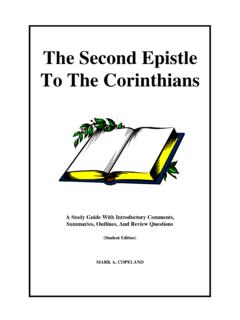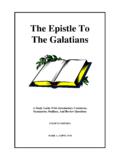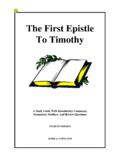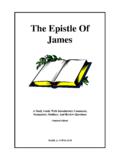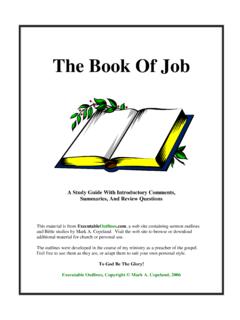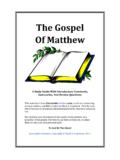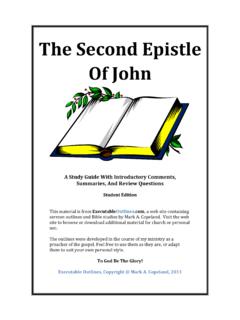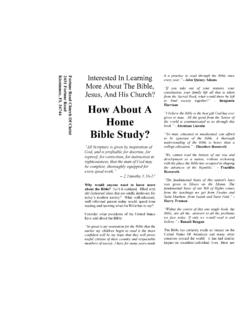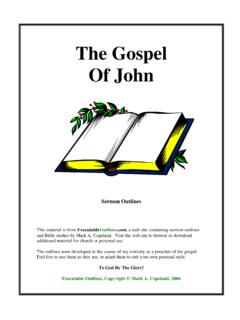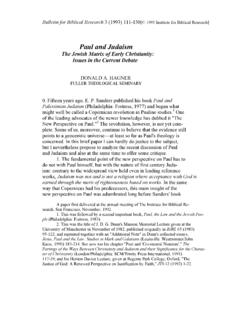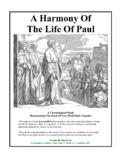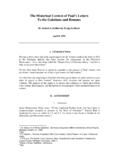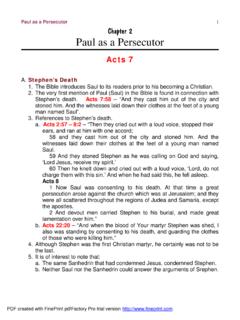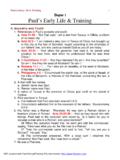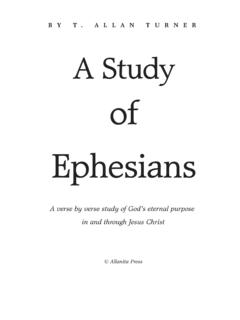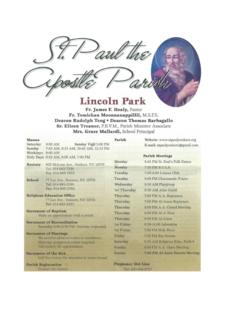Transcription of The Epistle To The Philippians - Executable Outlines
1 The Epistle To The Philippians A Study Guide With Introductory Comments, Summaries, Outlines , And Review Questions (Student Edition). MARK A. COPELAND. Mark A. Copeland The Epistle To The Philippians Table Of Contents Introduction 3. Chapter One 8. Chapter Two 11. Chapter Three 15. Chapter Four 18. This material is from , a web site containing sermon Outlines and Bible studies by Mark A. Copeland. Visit the web site to browse or download additional material for church or personal use. The Outlines were developed in the course of my ministry as a preacher of the gospel. Feel free to use them as they are, or adapt them to suit your own personal style. To God be the glory! Executable Outlines , Copyright Mark A. Copeland, 2002. The Book Of Philippians 2. Mark A. Copeland The Epistle To The Philippians Introduction AUTHOR. The apostle paul (1:1), joined in his salutation by Timothy. Personal references by the author (1:12-14; 2:19-24; 3:4-7; 4:15-16) are certainly consistent with what we know of paul from other New Testament sources.
2 paul 's authorship of this letter is also supported by the testimony of early "church fathers" such as Polycarp and Irenaeus. THE CITY OF PHILIPPI. Named after Philip of Macedonia, the father of Alexander the Great, it was a major city of Macedonia on the road from Rome to Asia known as the Egnatian Way. It was the site of a famous battle in 42. in which Antony and Octavius defeated Brutus and Cassius. In 30 , Octavian made the town a Roman colony where retired soldiers could live and enjoy the full privileges of Roman citizenship (to which paul may have alluded in 3:20). THE CHURCH AT PHILIPPI. During his second missionary journey (49-52 ), paul and his traveling companions (Timothy and Silas) were making their way across Asia Minor (Turkey) when paul received a vision at Troas. In the vision, a man of Macedonia pleaded, "Come over to Macedonia and help us." Perceiving that the Lord was calling them to go to Macedonia, they sailed from Troas (Luke having joined them) and eventually arrived at Philippi (Ac 16:6-12).
3 With the conversion of Lydia (Ac 16:13-15) and the Philippian jailor (Ac 16:25-34), the church was established at Philippi. The lack of a synagogue seems to indicate that Jews were not prevalent and so the church may have consisted primarily of Gentiles. From the conversion of Lydia and references in the Epistle itself (4:2-3), it is evident that a number of women played a role in the growth of the church. When it became necessary for paul to leave, Luke seems to have stayed at Philippi (based upon careful observations of personal pronouns; , "we, they", cf. Ac 16:12; 17:1). As paul left Macedonia, the church at Philippi became a significant source of support (4:15-16; 2 Co 11:9). paul visited the church at Philippi again on his third missionary journey (Ac 20:3,6). TIME AND PLACE OF WRITING. Philippians is one of paul 's four "prison epistles" (1:7,13,17; cf. Ephesians, Colossians, and Philemon). The general consensus is that these epistles were written during paul 's imprisonment at Rome (cf.)
4 Ac 28:16,30-31). If such is truly the case, then paul wrote Philippians around 61-63 from Rome. The Book Of Philippians 3. Mark A. Copeland PURPOSE OF THE Epistle . The church at Philippi had sent a gift to paul in Rome by the hand of Epaphroditus (4:10,18). paul uses this occasion not only to thank them, but to comfort them concerning his situation as a prisoner for Jesus Christ (1:12-14). He also writes of his plans to send Timothy soon (2:19-24), and why he considered it necessary to send Epaphroditus back to them (2:25-30). There may have also been a problem at Philippi involving two women, for paul has a few words to say concerning them (4:2-3). THEME OF THE Epistle . Throughout this short and rather personal Epistle , one keynote resounds again and again. That keynote is joy. Five times the word "joy" (Grk., chara) is found (1:4,25; 2:2,29; 4:1), and the verb "to rejoice". (Grk., chairein) occurs eleven times (twice in 1:18; 2:17,18; 4:4; once in 2:28; 3:1; 4:10).
5 For this reason, the Epistle to the Philippians has often been called paul 's "hymn of joy" in which the theme is: "REJOICE IN THE LORD!". KEY VERSE: Philippians 4:4. "Rejoice in the Lord always. Again I will say, rejoice!". outline . INTRODUCTION (1:1-11). 1. Salutation (1-2). 2. Thanksgiving and prayer (3-11). I. THE SITUATION IN ROME (1:12-26). A. paul 'S IMPRISONMENT AND OPPOSITION (1:12-18). 1. Imprisonment has actually created opportunities to spread the gospel (1:12-14). 2. Even opposition has provided opportunity for Christ to be preached (1:15-18). B. paul 'S EXPECTATION OF DELIVERANCE (1:19-26). 1. By their prayers and the provision of the Holy Spirit, he knows all will turn out well for his salvation (1:19-20). 2. Whether he lives or dies, it will be a blessing (1:21-23). 3. Knowing their need of him at the present, he is confident of coming to them once again (1:24-26). II. EXHORTATION TO BEHAVIOR WORTHY OF THE GOSPEL (1:27-2:18). A.
6 STAND FAST IN ONE SPIRIT (1:27-30). 1. Strive together for the faith of the gospel (1:27). The Book Of Philippians 4. Mark A. Copeland 2. Do not be terrified by your adversaries (1:28-30). B. BE OF ONE MIND BY FOLLOWING THE EXAMPLE OF CHRIST (2:1-11). 1. Make paul 's joy complete by being like-minded, having the same love (2:1-2). 2. In humility, look out for the interests of others (2:3-4). 3. Follow the example of Christ's humility (2:5-11). C. SHINE AS LIGHTS IN THE WORLD (2:12-18). 1. By working out their own salvation, for it is God who is at work in them (2:12-13). 2. As children of God, blameless and harmless (2:14-16). 3. Consider paul 's imprisonment as a reason to rejoice (2:17-18). III. PLANS INVOLVING TIMOTHY AND EPAPHRODITUS (2:19-30). A. TO SEND TIMOTHY SOON (2:19-24). 1. paul plans to send him shortly (2:19). 2. Commendation of Timothy (2:20-22). 3. Timothy to come soon, hopefully followed by paul himself (2:23-24). B. TO SEND EPAPHRODITUS AT ONCE (2:25-30).
7 1. Why paul felt it necessary to send Epaphroditus (2:25-28). 2. Receive him in the Lord with all gladness (2:29-30). IV. WARNINGS AGAINST JUDAISM AND ANTINOMIANISM (3:1-21). A. AGAINST JUDAISM (3:1-11). 1. Rejoice in the Lord, bewaring of those who place confidence in the flesh (3:1-3). 2. If anyone had reason to boast in the flesh, it would have been paul (3:4-6). 3. But he gave it all up, that he might know Christ and the power of His resurrection (3:7-11). B. AGAINST ANTINOMIANISM (3:12-21). 1. paul 's attitude of pressing on to perfection (3:12-14). 2. An exhortation for them to have the same mind (3:15-17). 3. A warning against those who serve their own desires (3:18-19). 4. A reminder of our true citizenship, and the hope it entails (3:20-21). V. EXHORTATIONS TO UNITY, JOY, AND PEACE (4:1-9). A. AN APPEAL TO EUODIA AND SYNTYCHE (4:1-3). 1. Prefaced with an exhortation to stand fast in the Lord (4:1). 2. A plea for them to be of one mind, assisted by others (4:2-3).
8 B. EXHORTATION CONCERNING JOY AND PEACE (4:4-9). 1. Rejoice in the Lord always, and be gentle to all (4:4-5). 2. Through prayer, let the peace of God guard your hearts from anxiety (4:6-7). 3. Meditate upon things worthy of virtue and praise, and follow paul 's example (4:8-9). The Book Of Philippians 5. Mark A. Copeland VI. THANKSGIVING FOR THEIR GENEROSITY (4:10-19). A. THEIR GIFT A SOURCE OF JOY TO paul (10-14). 1. paul rejoiced when they were able to care for him again (4:10). 2. Not that he really had need, for he had learned contentment (4:11-13). 3. But they have done well to share in his distress (4:14). B. THEIR GIFT A SOURCE OF BLESSING FOR THEMSELVES (15-19). 1. A brief history of their giving to paul (4:15-16). 2. Their giving abounds to their own account, viewed as an acceptable sacrifice to God, who will supply all their need (4:17-19). CONCLUSION (4:20-23). 1. Praise to God (4:20). 2. Greetings from those with paul , even those of Caesar's household (4:21-22).
9 3. Final benediction (4:23). REVIEW QUESTIONS FOR THE INTRODUCTION. 1) On which missionary journey was the church at Philippi established? 2) Where can we read about the beginning of the church at Philippi? 3) Who seems to have stayed at Philippi after paul left? (cf. "we, they", Ac 16:12; 17:1). 4) From where and when did paul write Philippians ? 5) What three other epistles were written about this time? What are the four epistles sometimes called? 6) What prompted the writing of Philippians ? (cf. Ph 4:10,18). 7) From Acts 16 and Philippians 4, who were some of the members of the church at Philippi? The Book Of Philippians 6. Mark A. Copeland 8) What is the theme running throughout this Epistle ? Which verse stands out as the key verse? 9) List the six main sections of this Epistle as given in the above outline The Book Of Philippians 7. Mark A. Copeland The Epistle To The Philippians Chapter One OBJECTIVES IN STUDYING THIS CHAPTER. 1) To appreciate why the Philippians were a source of great joy to paul 2) To learn from paul 's attitude concerning persecution, death, and the purpose of life SUMMARY.
10 paul begins his Epistle with his customary salutation followed by an expression of thanksgiving and prayer. The church at Philippi had been a source of great joy to paul by virtue of their fellowship with him in the proclamation of the gospel. Confident that God will complete the work He began in them, paul prays that their spiritual growth will continue (1-11). His circumstances at Rome have actually been for the furtherance of the gospel, despite imprisonment and opposition by false brethren. He is confident that everything will turn out all right, and that he will even come to them again. It is not without mixed feelings, however, for he is torn between a desire to be with Christ and a realization that to remain in the flesh is more needful for them (12-26). At the moment, his desire is that whether absent or present he may hear they are conducting themselves worthy of the gospel, by standing fast in one spirit and one mind for the gospel and not disturbed by any adversaries.
